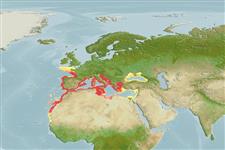Environment: milieu / climate zone / depth range / distribution range
Écologie
marin; saumâtre; océanodrome (Ref. 51243); profondeur 0 - 500 m, usually 5 - 250 m (Ref. 54928). Subtropical; 50°N - 16°N, 20°W - 43°E
Eastern Atlantic: Bay of Biscay to Mauritania including the Mediterranean Sea. The subspecies Trachurus mediterraneus ponticus occurs in the Marmara and Black seas, southern and western parts of the Azov Sea.
Length at first maturity / Taille / Poids / Âge
Maturity: Lm 20.0 range ? - ? cm
Max length : 60.0 cm FL mâle / non sexé; (Ref. 3397); common length : 30.0 cm FL mâle / non sexé; (Ref. 3397)
Adults are found usually near the bottom, at times also in surface waters; pelagic and migratory in large schools. They feed on other fishes especially sardines, anchovies, etc. and small crustaceans (Ref. 4233). Eggs are pelagic (Ref. 4233).
Smith-Vaniz, W.F., 1986. Carangidae. p. 815-844. In P.J.P. Whitehead, M.-L. Bauchot, J.-C. Hureau, J. Nielsen and E. Tortonese (eds.) Fishes of the north-eastern Atlantic and the Mediterranean. UNESCO, Paris. vol. 2. (Ref. 4233)
Statut dans la liste rouge de l'IUCN (Ref. 130435)
Menace pour l'homme
Harmless
Utilisations par l'homme
Pêcheries: commercial; pêche sportive: oui
Outils
Articles particuliers
Télécharger en XML
Sources Internet
Estimates based on models
Preferred temperature (Ref.
123201): 13.2 - 21, mean 17.4 °C (based on 748 cells).
Phylogenetic diversity index (Ref.
82804): PD
50 = 0.5001 [Uniqueness, from 0.5 = low to 2.0 = high].
Bayesian length-weight: a=0.00891 (0.00773 - 0.01028), b=2.96 (2.93 - 2.99), in cm total length, based on LWR estimates for this species (Ref.
93245).
Niveau trophique (Ref.
69278): 3.8 ±0.3 se; based on diet studies.
Résilience (Ref.
120179): Milieu, temps minimum de doublement de population : 1,4 à 4,4 années (K=0.22; tmax=12).
Prior r = 0.51, 95% CL = 0.33 - 0.76, Based on 5 stock assessments.
Fishing Vulnerability (Ref.
59153): Moderate vulnerability (36 of 100).
Climate Vulnerability (Ref.
125649): Moderate to high vulnerability (50 of 100).
Nutrients (Ref.
124155): Calcium = 215 [146, 344] mg/100g; Iron = 3.76 [2.38, 6.28] mg/100g; Protein = 19.8 [19.1, 20.4] %; Omega3 = 0.38 [0.27, 0.54] g/100g; Selenium = 26 [17, 40] μg/100g; VitaminA = 13.8 [3.7, 48.1] μg/100g; Zinc = 1.94 [1.49, 2.61] mg/100g (wet weight); based on
nutrient studies.
